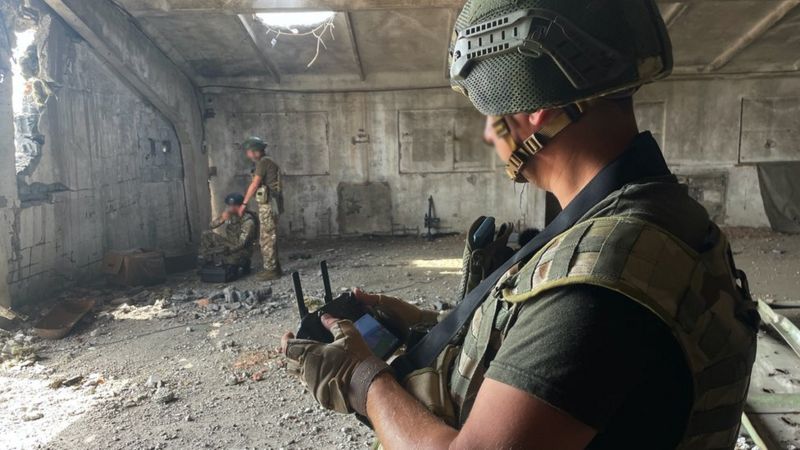Ukrainian forces are employing quadcopters that are accurately dropping grenades to destroy Russian tanks valued at several million dollars, continuing the success story of drones eliminating Russian heavy weaponry.
In a video that has gone viral on social media, two abandoned Russian T-72B3M tanks worth millions of dollars are seen being destroyed by a small drone that delivered accurate hits.
As shown in the video clip, the unmanned aerial vehicle of the Ukrainian forces hovered over the tanks before carefully aiming and dropping the ammunition.
Video of a Ukrainian UAV dropping munitions on two abandoned Russian T-72B3M tanks. https://t.co/nXnEBkz73z pic.twitter.com/l5G3khWwQ7
— Rob Lee (@RALee85) August 17, 2022
Given that the quadcopter and grenade used in the attack likely would not have cost more than a few hundred dollars, the damage to the tanks represents a far more significant loss.
Although a 40-mm grenade launched from an under-barrel grenade launcher cannot indeed kill a tank, the video demonstrates that the grenade did enough damage to the tank since it entered an open hatch and caused ammunition to detonate.
In the video, one can see how the heavy fighting vehicle instantly turned into a large burning ball after a grenade hit the tank’s turret.

Russian tanks have suffered heavy losses on the front lines as Ukrainian artillery refined their skills at striking specific vehicles with the help of drones. Moreover, Kyiv received many Javelins and other anti-tank weapons from the West.
It’s not the first time that these videos have gone viral online. Earlier, an octocopter drone produced in Ukraine with two bomblets fitted under it was displayed in a photo issued by Aerorozvidka, responsible for expanding Ukraine’s use of small drones in warfare.
In April, Aerorozvidka posted a video illustrating the tail-finned explosives being deployed by drones before exploding dramatically to eliminate armored vehicles.
Deployment Of Drones By Ukrainian Forces
A large portion of the public’s perception of the Ukraine war is shaped by drone footage of grenades dropping on soldiers and armored vehicles.
Drones have never been utilized as extensively in a battle as now. The Russians and the Ukrainians rely considerably on unmanned aerial vehicles to locate enemy positions and direct their menacing artillery attacks. Drones have been employed extensively by Ukraine in particular.
There is a high demand for off-the-shelf consumer models in Ukraine, and there are ongoing efforts to modify hobby drones to make them more jam-resistant.
Drones for basic photography are helpful on the Ukrainian battlefield. Videos demonstrate how soldiers utilize these drones, which one can purchase online for recreational use to spy on Russian troops and determine the best angle of attack.
Other drones have been modified to carry small explosives that can be dropped on the adversary. These commercial UAVs are just one example of the creative, “DIY” techniques the Ukrainian army has employed to counter Russian assaults.
However, the civilian models that most Ukrainians use are easily identified and destroyed. And within minutes of a drone being discovered, Russian artillery frequently strikes its operators.
The Bayraktar TB-2 laser-guided, bomb-dropping drone, a star of the early stages of the conflict for Ukraine, has also lost some of its potency in the face of intensifying Russian air and electronic defenses in eastern Ukraine. It was the focal point of a lot of Ukrainian nationalist videos.
According to an analysis from Britain’s RUSI think tank, the average lifespan of a Ukrainian drone is currently under a week. Russian electronic warfare units significantly limit Ukrainian surveillance, and Kyiv urgently needs radar-seeking killer drones capable of destroying them.
Hundreds of drones have been sent by the United States and other Western allies, including an undisclosed number of “kamikaze” Switchblade 600s equipped with tank-piercing warheads. They have a 70 mph top speed and employ artificial intelligence to follow targets. However, their range is constrained, and they can only stay in the air for around 40 minutes.
Nevertheless, videos circulating on the internet demonstrate that despite Russian troops having the technology to disrupt drone controls, drone pilots, in some instances, have been able to blow up valuable vehicles with explosives that are probably cheaper than $100.
Due to the recent advancement in low-cost drone warfare, Russian armored vehicles positioned near Ukrainian lines may face an increasing challenge.
- Contact the author at ashishmichel@gmail.com
- Follow EurAsian Times on Google News